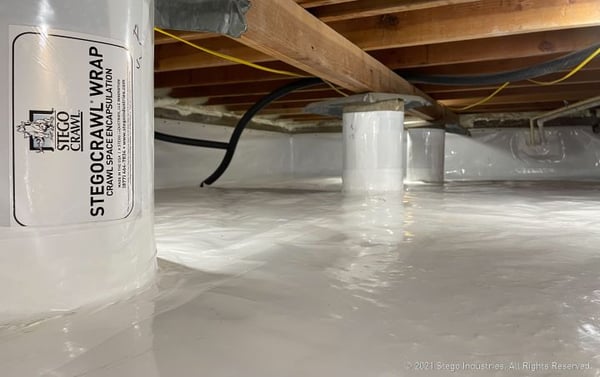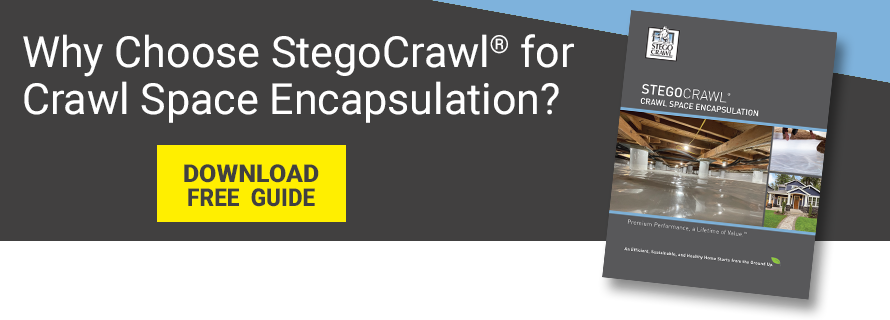Is the Flooring Above Your Crawl Space Cupping or Warping?
Manage Crawl Space Moisture to Protect Your Floor Health
.jpg?width=720&height=378&name=StegoCrawl-CuppingOrWarping-1200x630%20(002).jpg)
I received a call recently from a homeowner who had a hardwood flooring problem she suspected was due to moisture in her crawl space. Prior to calling me, she’d had two flooring contractors out to investigate her situation. The first was happy to replace her “cupped” or “warped” hardwood floors, but just to shop out his quote, she had a second flooring contractor out to the house as well. To his credit, the second contractor identified the source of the problem.
He pointed out that her home was built on a crawl space and through his years of experience he had seen this issue before — and the culprit was likely moisture building up. He could replace her floors, but without resolving the moisture in the crawl space, the new flooring he installed would likely cup or warp all over again. Not great news for the homeowner because her problem just got a little more expensive to solve, but at least she wouldn’t be wasting her money with a temporary fix.
The contractor referred her to a general carpenter who could evaluate her crawl space. The carpenter confirmed that it appeared damp in the crawl space and that there was poly, but that it was misplaced and there were large gaps in the coverage. The carpenter recommended that he could sufficiently dry out the crawl space by re-laying out the 6 mil poly and installing a dehumidifier. Once that was done, he advised that the flooring contractor return and make repairs to the flooring. The contractor's suggestion didn't seem adequate to the homeowner so she got online to see what other solutions she could come up with, and that’s when she found and called me. Her situation is pretty typical so I thought I would write this article to shed light on the topic for others who may be experiencing similar issues.
Signs Crawl Space Moisture May Be an Issue
There are three major problems that can affect flooring above a crawl space and these can occur regardless of whether it’s a new home or an existing home:
- Visible Flooring Damage
- Wood floors may appear scalloped, buckled, cupped, warped, or sagging
- Vinyl or linoleum flooring may bubble, wrinkle, make popping noises when you step down, or generally delaminate
- Visible mold growth on the baseboards and flooring
- Musty, mildewy odors emanating from the crawl space
Wood flooring can be particularly problematic for homeowners because of its hygroscopic qualities, which means it will seek out and retain moisture from the surrounding environment. This can come from a few different places:
Absorption of moisture from the air above the crawl space in the living area can happen in homes in a humid climate, but generally, only if they have had the electricity off or had the windows closed for an extended period of time. But typically, most homes, regardless of climate, will not have enough moisture in the air above the flooring to contribute to a flooring failure of the magnitude discussed above. For this homeowner, we could reasonably rule out moisture above the flooring as being the primary culprit.
However, we couldn’t ignore that her home had been built over a vented crawl space roughly three feet tall. Many homeowners use air conditioning to make their indoor environment more comfortable during warm times of the year. Nature is constantly trying to reach equilibrium, so if it’s warmer outside than it is inside, the warm air tries to enter the home from all six sides — four vertical sides, a roof, and a subfloor. When that happens, the warm air laden with moisture (especially from the ground), enters the home at an exacerbated rate. That’s when the floor begins to cup — and when the wood floor reaches its limit of expansion, it buckles.
Tips for Preventing Damage to Your Flooring Above a Crawl Space
Most new homes being built on crawl spaces today, are being built on closed (meaning no vents), conditioned, or dehumidified crawl spaces. (Check local code for building requirements.) In addition to that, the crawl space walls are insulated with rigid foam, and 6 mil poly at a minimum covers the ground and ideally up the vertical walls. Last but not least, a forced-air register can condition the area.
This homeowner’s home, however, wasn’t originally built that way, so here’s what she can do retroactively:
- Install gutters and slope the grade away from the foundation. On average, downspouts should empty 8 to 10 feet from the foundation.
- Close the vents, and block and seal the vents with insulation board to prevent the warm, moist air from getting into the crawl space.
- Install a non-deteriorating vapor barrier** (generic poly can deteriorate over time, regardless of thickness) over the ground and vertical walls of the crawl space.
- If there is open-cell insulation between the floor joists, remove it and insulate the vertical walls with closed-cell insulation instead.
In the retrofit for this homeowner, I recommended she hire a contractor who would be willing to install a 15 mil vapor barrier made from high-grade virgin polyolefin resin. Compared to materials like generic polyethylene, which has higher water vapor permeance, punctures easily, and may degrade quickly (and is a common choice for contractors hoping to meet minimum code requirements), prime, virgin resins offer a longer lifespan, generally higher puncture resistance, and much lower moisture permeance, meaning less moisture can pass through.
While this work is being done, this is also a great time to replace any sub-flooring and floor joists that may have rotted. This is not a time to save anything that’s been exposed to excess moisture. Make sure the new sub-floor you’re installing is dry and acclimated to the home’s temperature. It may be a good idea to also run a dehumidifier in the crawl space for several weeks to bring the moisture content under control. From that point forward, the space should be much healthier, and the flooring above the crawl space can be replaced with a better chance of long-term success.
Don’t Neglect Your Crawl Space
According to Dr. Joseph Lstiburek, a leading expert on vapor barrier installation in the U.S. and Canada, a ventilated crawl space is probably one of the worst things you can build into a house, in any climate.
He advises homeowners, “All crawl spaces should be dry, warm, part of the house, not part of the outside or part of the ground.”
Your crawl space is part of your home and needs proper care and attention. Most flooring problems can be prevented through keeping your crawl space dry and comfortable, just as you would the rest of your home.
Choosing the Right Vapor Barrier
Vapor barriers are a relatively quick and inexpensive fix for existing crawl spaces. They can lead to lasting changes in your home, but some materials are better than others. Make sure you do your research and call a professional to find the right solution for you.

** Note: Products that have been tested to ASTM E1745 - 11 Standard Specification for Plastic Water Vapor Retarders Used in Contact with Soil or Granular Fill Under Concrete Slabs will typically provide better longevity than generic plastic products.
Editor's note: This blog post was initially published in June 2016 and has been revised to stay up-to-date.

Written by Tom Marks
Tom Marks is the Business Development Project Manager with Stego Industries, LLC. He has been with Stego since 2007, serving many years as the Rocky Mountains Regional Manager. Now, his focus is geared toward vapor barrier solutions for new and existing homes as the Product Manager of the StegoHome and StegoCrawl brands. In addition, Tom serves as Sustainability Manager, overseeing Stego’s leadership in holistic product and corporate sustainability. Tom enjoys working with a wide range of project team members and customers to incorporate effective sub-slab vapor protection and create healthy, sustainable homes and buildings.
- Stego (26)
- StegoCrawl (24)
- Stego-Awareness (17)
- StegoHome (15)
- Case Studies (14)
- StegoCrawl-Consideration (12)
- StegoCrawl-Awareness (11)
- Customer Stories (9)
- Stego-Consideration (9)
- Pango (8)
- StegoHome-Consideration (8)
- Beast (7)
- How to Install (7)
- StegoHome-Awareness (7)
- Drago (5)
- Pango-Awareness (5)
- Beast-Awareness (4)
- Beast-Consideration (3)
- Drago-Awareness (3)
- Pango-Consideration (3)
- Stego IQ (3)
- Drago-Consideration (2)
- StegoCrawl-Decision (2)
Popular Posts
Stay Connected.
Enter your email below.








Post Comments